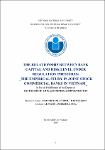| dc.description.abstract | Facing with the current state, the commercial banks in Vietnam has been struggling to meet the government regulations along with high risky asset portfolios, which threatens the banking system. Therefore, this paper is to examine the concurrent relationship between bank capital adequacy and risk-taking behavior under regulatory constraints through the sample of joint-stock commercial banks in Vietnam. Following strictly to the key paper of Maraghni (2016), the study is constructed with the sample of 20 Vietnamese joint-stock commercial banks in 10 years period (2007-2016) to investigate the capital-risk association by measuring the risk index and capital adequacy ratios. The research has panel data that is found from the financial statements and annual reports of each banks. In addition, the findings are accounted of two simultaneous equations that is inspired mainly from Shrieves and Dahl (1992).
For the regression analysis, the research goes through three techniques (OLS, 2SLS, 3SLS) to find out the more robust result. The comparison of two executions between “Ordinary Least Square” (OLS) and “Two-stage Least Square” (2SLS) states for the ambiguous outcomes of the relationships because of the endogenous problem. Therefore, this study discusses the results from execution of Three-stage Least Square (3SLS) for clearer responses. The result shows the main concern that capitalization level relates negatively with the taking risk behaviors of commercial banks, which is positive when comparing with the risk index. Moreover, under regulatory stresses, the requirements of capital may not indicate negatively or positively the incentive in taking risk. Besides, the negative and statistically significant effect of regulatory constraints on the ratio of capital adequacy can be seen only under 3SLS technique. From the research sample, Vietnamese joint-stock commercial banks would prefer increase risk when ratio of non-performing loans rises, but the capitalizing effort is not enough. This situation proves the presence of moral hazard resulting from the safety assurance of government or State Bank in other words. Therefore, when banks raise the level of capital, they have a tendency in avoiding risky assets. | en_US |


